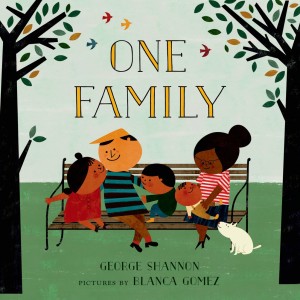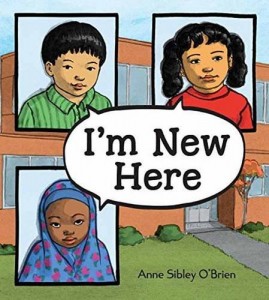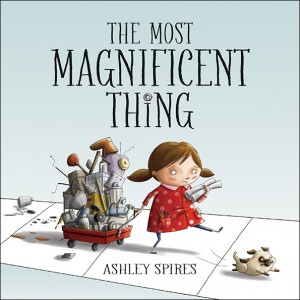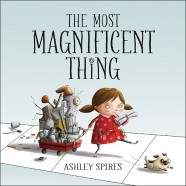“One Family” is one you need for Thanksgiving!
 Thanksgiving is my favorite holiday, but it’s a challenge to find Thanksgiving picture books that connect with kids (I find many “pilgrim and Indian” books that are cringeworthy with stereotypes). This year, I’m focusing on the “thanks” in Thanksgiving and sharing One Family by George Shannon with pictures by Blanca Gomez.
Thanksgiving is my favorite holiday, but it’s a challenge to find Thanksgiving picture books that connect with kids (I find many “pilgrim and Indian” books that are cringeworthy with stereotypes). This year, I’m focusing on the “thanks” in Thanksgiving and sharing One Family by George Shannon with pictures by Blanca Gomez.
The simple counting book is elevated here to show the beauty of what a family can be.
Counting up to ten, we see all kinds of inclusive loving groups: two dads and their daughter (all with different shades of skin), grandparents and kids, a family where the dad and his sons are wearing turbans, a mix of adults and kids where it’s not clear what the relationships are but who cares because they’re smiling and together. On the last page showing all the people we read, “One is one and everyone. One earth. One world. One family.”
Use this book to inspire your students to write and draw about their own families. To continue the counting 1 to 10 structure, students can write about what they are thankful for this holiday. Pair this with the wonderful new nonfiction book Families by Shelly Rotner and Sheila M. Kelly if you want to compare and contrast to hit the Integration of Knowledge & Ideas standard. I count you among my many blessings!
Read MoreSeptember Bonus List of Books and Activities!
Because I gave a presentation to awesome librarians this month and I couldn’t resist sharing all the great ideas we came up with, you get a bonus post this month! And because you’re getting a bonus post, I hope you’ll allow me to indulge in a bit of horn-tooting.
My debut picture book, GROUNDHOG’S DILEMMA, illustrated by Matt Faulkner (swoon!) will be published by Charlesbridge this December 1st, and it recently received a good professional review:
“Faulkner’s anthropomorphic animals and vibrant colors recall Uncle Wiggly, and the illustrations are packed with humorous details that repay rereadings. Remenar’s graceful prose and the subtlety of her message, pitched to older preschoolers and early-elementary students, are a good match. A sly and funny take on truth-telling and friendship.” – Kirkus, Oct. 2015
Woohoo!!!!!!!
Ok, horn-tooting over.
I spent a morning with a roomful of youth librarians and bunches of new books. We came up with these activities revolving around the key early literacy skills: Talk, Sing, Read, Write, Play. (Look here for lots more good stuff from Every Child Ready to Read.) Many of our activities can be used with a variety of books. I’m including our list of ideas and the books we shared. Enjoy!
TALK:
* Read Rufus Goes to School by Kim T. Griswell and talk about what you need for school, what you shouldn’t do in school, and favorite books you know how to read.
* Read Groundhog’s Dilemma by Kristen Remenar and talk about your favorite/least favorite parts of winter and spring. Talk about animals that hibernate and those that don’t. Talk about why the characters in the story wanted or didn’t want Groundhog to see his shadow.
* Read Clothesline Clues to Sports People Play by Andy Robert Davies and encourage kids to guess the sport. Discuss unfamiliar terms like foil and quiver.
* Use nonfiction books with photos of bees to go along with Bee Dance by Rick Chrustowski. Bring in a honeycomb and give kids bendy straws so they can act like the bees in the book.
* Read Pepper and Poe by Frann Preston-Gannon and discuss why Pepper feels the way he does.
* Discuss good and bad manners after reading The Entertainer by Emma Dodd.
* Encourage kids to respond to “which would you choose?” while reading Hot Rod Hamster by Cynthia Lord.
SING:
* Sing rhyming words, even nonsense ones, after reading Hi! by Ethan Long.
* Sing “Milkshake” after reading Lulu’s Party by Kit Chase.
* Sing the book Old Mikamba Had a Farm by Rachel Isadora.
* Sing “The Days of the Week” song after reading Pepper and Poe by Frann Preston-Gannon, or “If You’re Happy and You Know It”.
* Sing “Take Me Out to the Ball Game” after reading Groundhog’s Dilemma by Kristen Remenar.
READ:
* Read nonfiction books about groundhogs and Groundhog’s Day along with Groundhog’s Dilemma by Kristen Remenar. (It delights me every time I type it!) Use puppets to help narrate/read the story.
* Use magnetic or felt letters to rearrange and read aloud, after reading Little Bird’s Bad Word by Jacob Grant.
WRITE:
* Kids can decorate the first letter of their name or make pictures with die-cut letters after reading Alphabeasties by Sharon Werner and Sarah Forss.
* Write your own “wumbers” inspired by Wumbers by Amy Krouse Rosenthal and Tom Lichtenheld.
* Draw or write about something you cherish after reading Thankful by Eileen Spinelli.
* Trace your shoes and decorate the tracings after reading Whose Shoe? by Eve Bunting.
* Write a letter or draw a picture to convince Groundhog to predict winter or spring after reading Groundhog’s Dilemma by Kristen Remenar. Kids can write and draw about a time when they’ve had to resolve a dilemma. Outside with chalk, or inside on paper, kids can trace their own shadows!
* Create maps of your playground, classroom, school, library, etc. after reading Henry’s Map by David Elliot.
* Paint Q-tip paintings of trees inspired by Fall is Not Easy by Marty Kelley.
* Write your own “word equations” inspired by This Plus That by Amy Krouse Rosenthal.
PLAY:
* Use a string and pin it to a world map to show all the places from Because Amelia Smiled by David Ezra Stein. Compare it to Madlenka and Nothing Ever Happens on My Block.
* Act out Uh Oh! by Shutta Crum.
* Play a version of “Going On a Bear Hunt” after reading In the Canyon by Liz Garton Scanlon.
* Incorporate different dances like The Hokey Pokey and The Twist and act out The Sky Is Falling by Mark Teague. Have a dance party!
* Create hand/body motions and make the sound effects for Niňo Wrestles the World by Yuyi Morales. Come up with other characters who might want to wrestle!
* Move like cats and act out the emotions from Pepper and Poe by Frann Preston-Gannon.
* Have a storytime party where kids act out what should and should not happen at a party after reading The Entertainer by Emma Dodd.
* Paint small boxes like houses after reading Vincent Paints His House by Tedd Arnold.
* Rearrange letter tiles to show how one word can become another after reading One Boy by Laura Vaccaro Seeger.
* Act out Groundhog’s Dilemma by Kristen Remenar. (Still fun to type!) Little ones can curl up in a box and pop out for Groundhog’s Day to look for their shadows, or try making shadow animals on a wall.
I’m New Here
 It’s September, the start of a new school year. I have no apples for you teachers, but I do have the perfect back-to-school picture book to teach empathy and point of view: I’m New Here by Anne Sibley O’Brien.
It’s September, the start of a new school year. I have no apples for you teachers, but I do have the perfect back-to-school picture book to teach empathy and point of view: I’m New Here by Anne Sibley O’Brien.
Maria, Jin, and Fatimah are new to their schools and to the United States. Through their stories, we get a glimpse of what it’s like to hear a new language, to see a new alphabet, and to try to pick up a new set of classroom expectations. “Back home… I knew just what to do.” All of your students can relate to the unsettled feeling of a first day in a new classroom. With I’m New Here, you can expand upon that feeling to help your students empathize with people who are new to our country. I love that Anne Sibley O’Brien not only shows what it’s like to be an immigrant, but how we all learn from each other. On one page, O’Brien writes from Jin’s point of view, “I am learning from others. And they are learning from me.” Jin asks a little boy, “How to spell cloud?” The boy responds, “C-L-O-U-D.” Jin holds up a piece of paper with Korean characters on it. “This is cloud in Korean.” “Cool.”
Michelle A., a gifted kindergarten teacher of English as a Second Language students and a remarkable friend, told me about Step Inside thinking. After you’ve read through the book, ask your students to “step inside” a character and imagine that they are Maria, Jin, or Fatimah. Students can write and draw from the perspective of the character, describing what was a challenge and what helped. You can turn this book into a readers’ theater script for students to perform, or have students take on the roles in an impromptu performance as you reread the book. As a class, you can talk and write about what you all can do to help a new student feel welcome. Whether or not you gain a new student during the year, all of your students will gain a wider, more empathetic perspective from I’m New Here.
Read MoreThe Most Magnificent Thing
 The perfectionist in me was upset to have missed posting last month, so as a reminder to be more patient with myself, I pulled out the very wise, very magnificent book, The Most Magnificent Thing by Ashley Spires.
The perfectionist in me was upset to have missed posting last month, so as a reminder to be more patient with myself, I pulled out the very wise, very magnificent book, The Most Magnificent Thing by Ashley Spires.
The unnamed girl has an idea for a magnificent thing. She uses all kinds of cool tools like hammers, screwdrivers and wrenches (rock on, tool girl) but she just can’t make in reality the fabulous idea in her head. She works and reworks it, but “(h)er hands feel too BIG to work, and her brain is too full of all the not-right things.” So many kiddos can relate to this feeling, and to the ensuing meltdown. Her assistant (her dog) suggests she take a walk, where the girl gets a break and a bit of perspective. In the end, she’s able to see that a part of her original creation can be reworked into a wholly new, magnificent thing. LOVE!
This is a wonderful book to share at the beginning of next school year. You and your students can discuss the universal feelings of frustration during the creative process, comment on how the girl worked through her angst, and come up with ways you can handle it in your classroom (your Self Smart kids excelling with Key Ideas and Details? Score!) Then, get out recycled stuff like paper towel tubes and fun art stuff like pipe cleaners and challenge your kiddos to build their own most magnificent thing. Kids can write and draw plans before building, and write descriptions of what they’ve made at the end. (What is that, exactly? It’s magnificent!) Assisting others and taking breaks are encouraged as part of the process.
Bringing tools like screwdrivers into the classroom can be tricky, but one successful way to do it is to have a “take apart” center. Ask for donations of broken electronics and small tools, or scour your local thrift shops. It’s great for fine motor skills to unscrew those little screws, and examining the inner workings of an old alarm clock is real-life science!
I have a really exciting reason for why I missed May’s post, and I’m glad the ink is on the contract so I can share it with everyone now: along with my picture book, GROUNDHOG’S DILEMMA, my second book will be published in December, 2015, too! DRAW WITH A VENGEANCE is a grown-up book, and since it comes from my snarky side, I’m using a pseudonym – Helen Wrath. For those of you kid-lit lovers who enjoy a bit of dark humor, I hope you’ll check it out!
Read More








